Retro In The '70s: Englehart & Rogers' Original Detective
First off, let me assure you the reader that despite a recent trend in my posts here, I am not fixated exclusively upon Batman and his associates. However, on May 4 DC will release the first issue of Batman: Dark Detective, the reunion of an acclaimed Batman creative team. Moreover, when TGC's own Alex Segura Jr. mentions in a comment he'd like to see something on Rupert Thorne and Silver St. Cloud (both created by the aforementioned team), it tends to sound like Donald Trump ordering a meatball pizza. I am happy to oblige, being a longtime fan of the Englehart/Rogers/Austin Detective Comics; but I promise, less Batman in the future.
Anyway. Back in 1977, writer Steve Englehart moved to DC from Marvel for a year's worth of work before he planned to move to Europe and retire from comics entirely.* During this period, he wrote 9 1/2 double-sized issues of Justice League of America (#s 139-46, 149-50), four issues of Mr. Miracle (#s 19-22), Kamandi #51, a couple of Starfires (#s 6-7), and eight issues of Detective Comics (#s 469-76, May 1977-March/April 1978). While Englehart's JLA issues stand out for me, they are nowhere near as revered as those Detectives.
Nevertheless, at first glance the biggest irony about Englehart's work here is that he obviously appropriates the style of the earliest Batman stories. By no means is this a criticism of Englehart's run -- in fact, it gives the work a legitimacy-through-nostalgia which allows Englehart to experiment with the character further.
Nostalgia was somewhat missing from the Bat-titles, given that Batman's then-recent history included much tweaking, if not outright reinvention. In 1964, incoming editor Julius Schwartz oversaw Batman's "New Look," which led to the "Batman" TV show phenomenon a couple of years later. The show left an indelible mark, so after its cancellation in 1969, writer Denny O'Neil and artists Neal Adams and Dick Giordano gave the hero his most lasting makeover, into what O'Neil's captions called "the dread Batman." Therefore, although nobody in 1977 wanted to reverse any of that, adopting the spirit of Batman's earliest adventures would still have satisfied contemporary tastes. Englehart's innovation was in showing that a "retro" Batman could, and did, work within the "new, hip" framework established in 1969. Although Robin was in college and Wayne Manor was boarded up, the core elements of Batman's mythology remained viable.
Engelhart basically tells five stories in the course of his eight issues. The first ('Tec #s 469-470, May-June 1977) introduces a new villain, Dr. Phosphorus, and sets up the two new supporting characters, Councilman Rupert Thorne ...
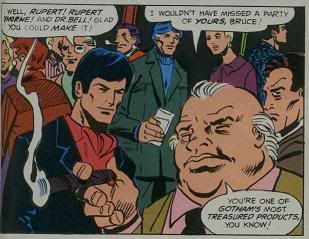
and businesswoman Silver St. Cloud.
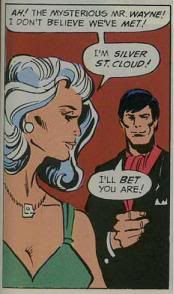
While the overall plot isn't that important, it establishes both Thorne's corruption and Silver's suspicions about Bruce; and gives Batman radioactive injuries which require his treatment (in #471) at an exclusive, no-questions-asked clinic.
Naturally, the clinic has a dark side, and Bruce is locked up. Changing to Batman and escaping the cell, he just as quickly discovers that his "doctor" is actually his old foe Hugo Strange -- last seen some 37 years before in Detective #46 (Dec. 1940). Strange's poisonous snake gets the jump on Batman, and the Darknight Detective awakens to learn he's been unmasked.
Detective #472 features a striking, ominous cover, with the caption "The Batman Is DEAD; Long Live The NEW Batman." As Bruce and Alfred struggle to escape Strange's prison, Silver calls Dick Grayson looking for Bruce; so Robin helps his mentor bust out. Meanwhile, Strange has left the scene in order to sell Batman's secret identity to the highest bidder. Those include the Penguin, Rupert Thorne, and the Joker, but Thorne is apparently the most serious, abducting Strange afterwards and torturing him to death. Strange never gives up the secret, considering Batman more honorable than Thorne.
The reunited Dynamic Duo, technically outlawed thanks to Thorne's politicking, thwart the Penguin in Detective #473. The story also advances Bruce's romance of Silver and shows the ghost of Hugo Strange haunting Thorne. 'Tec #474 featured the return of another long-forgotten villain, Deadshot, now clad in his familiar high-tech costume. The issue's climax occurs at an office-supplies trade show put on by Silver and featuring giant props, another hallmark of Batman's discarded past.
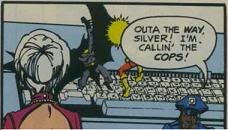
Although Batman defeats Deadshot atop a massive IBM Selectric, there is a cliffhanger -- Silver suddenly realizes she's been dating the Caped Crusader.
That revelation, undoubtedly shocking to readers at the time, built momentum into Englehart's final two-parter.** The Joker dumps his venom into the Atlantic Ocean, giving countless fish his permanent smile so that he can then copyright them and grow rich from the royalties. When the copyright officials refuse to go along, he threatens to kill each of them, one by one.
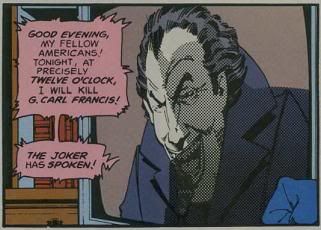
These sequences obviously evoke the Joker's first caper in Batman #1 (Spring 1940).
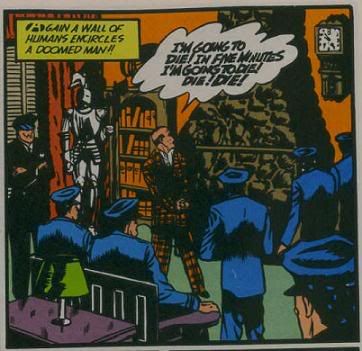
As Batman races to stop the Joker, Hugo Strange's ghost catches up with Thorne. The end of the story balances good news -- the Joker's apparent death, Thorne's confession -- with very bad news: Silver tells Batman she knows his secret, and tearfully breaks up with him. She leaves Gotham, never to return.
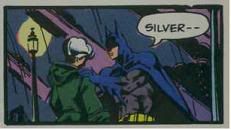
These issues of Detective allowed Englehart to examine the major relationships in Batman's life. His relationship with the police, and by extension the rest of Gotham City, was put in jeopardy by Rupert Thorne. His very identity was at risk from Hugo Strange. His relationships with Jim Gordon, Alfred, and Robin remained intact, but Englehart made a point to emphasize them. Most importantly, Englehart gave Bruce/Batman a real romance with a woman who wasn't easily dismissed. (As opposed to Talia al Ghul, who knew the secret but was hardly in the same kind of relationship with Batman.) Silver not only figured out Bruce's secret by herself, she survived the story with that knowledge intact -- and chose to walk away. At the risk of elevating the work unreasonably, it's almost Casablanca-esque, with the lovers sacrificing their relationship for the sake of a crusade.
This focus on positive relationships might well be a stretch today. It's hard to imagine the Batman and Nightwing of 2005 sparring merrily with each other as they did in the opening pages of 'Tec #473.
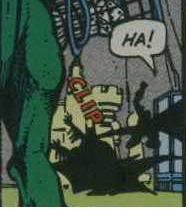
That goes double for Batman's social life. While most of his motion-picture love interests have learned the truth and lived, the comics have not been so generous. Dr. Shondra Kinsolving learned Bruce's secret during the "Knightfall" mega-arcs, but was left brain-damaged. Furthermore, the recent Bruce Wayne: Murderer? arc had as a subplot the suggestion that Batman may well have killed Bruce's girlfriend because she'd discovered his secret identity. The Batman of the 1970s was still very much the dark avenger molded by O'Neil and Adams, but he was also a lot friendlier.
Regardless, Batman is still pretty much the most serious character in these stories, and Englehart advances the theory that Bruce Wayne "has become a daytime mask for the Batman." This is the conventional wisdom today, but the difference is that Bruce himself apparently sees this as a more recent development, and in fact asks "would I have it any other way?" Thanks to Silver, Englehart never forces Bruce/Batman to choose between her and his costumed career, but we can see he's not happy about the breakup. Again, with today's Batman, you wouldn't think there'd be much of a debate, let alone a choice.
But enough about Steve Englehart -- let's talk about the art of Marshall Rogers and Terry Austin! Englehart's first couple of issues were pencilled by Walt Simonson, whose work then (at least to me) suffered mightily under the heavy inks of Al Milgrom. That wouldn't be a problem with Rogers and Austin's much cleaner, and more detailed, pages. Take a look at the care which went into this cityscape from Detective #473:
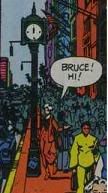
Englehart's script also gave Rogers the opportunity to do "dramatic reveals" of their hero

and his sidekick.
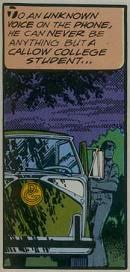
Still, nowhere is Rogers' skill at storytelling more evident than in the sequence which opens Detective #475, as Batman confronts Silver.
Page 1 sets the mood:
Page 2 raises the tension, presenting Batman as both seductive and dangerous in the best Bela Lugosi tradition.

Page 3 provides release, but the underlying tension remains.

Rogers moves Batman with expert skill, portraying action effectively through both choreography and "cinematography."

As the previous link to the breakup shows, he can also bring the same level of skill to character moments, or even "in-between" scenes like this bit with Strange's ghost.
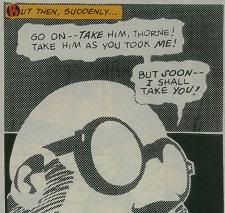
Since it was the '70s, some psychedelia was natural:
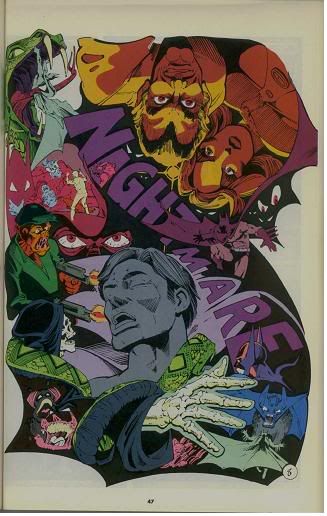
but even that seems to have taken its cue from this "Fear" panel in the aforementioned Detective #46.
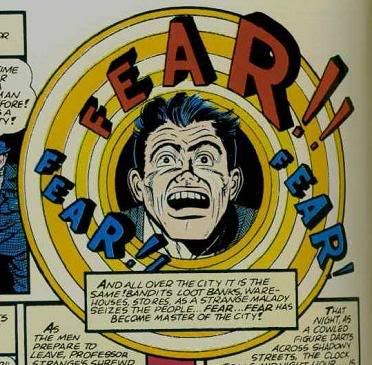
Rogers and Austin combined to produce art which, while sufficiently realistic, allowed for enough fantasy to suit the inhabitants of Batman's world. Although it was the height of the disco era, they even toned down Bruce's and Silver's fashions and hair enough to give their work a timeless quality. In fact, as much as Walt Simonson is admired for his craft, the Rogers/Austin issues have an energy all their own, and I wonder whether fans would still clamor for an Englehart/Simonson/Milgrom Batman.
Steve Englehart would return to Batman at least twice more in the next 28 years. First was "The Primal Riddle" in Legends of the Dark Knight #s 109-111 (Aug.-Oct. 1998; art by Dusty Abell and Drew Geraci). Batman suffers a near-death experience while battling the Riddler and his soul is severed from his body, wandering into various people and inspiring them to do heroic acts. If you could accept the concept, it was a good story. He then wrote a forgettable sequel to "The Laughing Fish," which had a great concept -- Aquaman comes looking for the man who poisoned all those fish -- but really poor execution. It featured art by Trevor von Eeden and appeared in Legends of the DC Universe #s 26-27 (March-April 2000).
Marshall Rogers pencilled the next two issues of Detective for writer Len Wein before leaving the title, but he also returned to Batman -- first for a Roy Thomas-written account of the Golden Age Batman's origin in Secret Origins #6 (Sept. 1986); then, as artist on the 1989-90 Batman newspaper strip (written by Max Allan Collins) and much later, for a five-part Legends of the Dark Knight (#s 132-36, Aug.-Dec. 2000) inked by Bob Wiacek and John Ceballos, plotted by the late Archie Goodwin, and scripted by James Robinson. That LOTDK story also heralded the return of Silver St. Cloud, but in a comparatively minor role. Nevertheless, with an all-star creative team, it was still a fine story, more concerned with Wayne family history and how the Wayne legacy was seen over the years than with Bruce and Silver's abortive romance.
Finally, with so many fond memories of these stories, the obvious question is whether the new Dark Detective will be any good. Nobody especially wants a sequel to Casablanca, and it seems inevitable that Bruce and Silver will each be alone at the end of this story too. At this point, it's too early to tell. DC would love for Englehart, Rogers, and Austin to follow Keith Giffen, J.M. DeMatteis, and Kevin Maguire by producing the same quality of work which previously endeared them to fans and critics alike -- but even if they pick up where their old Detectives left off, today's fans may have gotten used to a totally different Dark Knight.
* From Englehart's introduction to Batman: Strange Apparitions, the paperback which collects these Detectives.
Anyway. Back in 1977, writer Steve Englehart moved to DC from Marvel for a year's worth of work before he planned to move to Europe and retire from comics entirely.* During this period, he wrote 9 1/2 double-sized issues of Justice League of America (#s 139-46, 149-50), four issues of Mr. Miracle (#s 19-22), Kamandi #51, a couple of Starfires (#s 6-7), and eight issues of Detective Comics (#s 469-76, May 1977-March/April 1978). While Englehart's JLA issues stand out for me, they are nowhere near as revered as those Detectives.
Nevertheless, at first glance the biggest irony about Englehart's work here is that he obviously appropriates the style of the earliest Batman stories. By no means is this a criticism of Englehart's run -- in fact, it gives the work a legitimacy-through-nostalgia which allows Englehart to experiment with the character further.
Nostalgia was somewhat missing from the Bat-titles, given that Batman's then-recent history included much tweaking, if not outright reinvention. In 1964, incoming editor Julius Schwartz oversaw Batman's "New Look," which led to the "Batman" TV show phenomenon a couple of years later. The show left an indelible mark, so after its cancellation in 1969, writer Denny O'Neil and artists Neal Adams and Dick Giordano gave the hero his most lasting makeover, into what O'Neil's captions called "the dread Batman." Therefore, although nobody in 1977 wanted to reverse any of that, adopting the spirit of Batman's earliest adventures would still have satisfied contemporary tastes. Englehart's innovation was in showing that a "retro" Batman could, and did, work within the "new, hip" framework established in 1969. Although Robin was in college and Wayne Manor was boarded up, the core elements of Batman's mythology remained viable.
Engelhart basically tells five stories in the course of his eight issues. The first ('Tec #s 469-470, May-June 1977) introduces a new villain, Dr. Phosphorus, and sets up the two new supporting characters, Councilman Rupert Thorne ...

and businesswoman Silver St. Cloud.

While the overall plot isn't that important, it establishes both Thorne's corruption and Silver's suspicions about Bruce; and gives Batman radioactive injuries which require his treatment (in #471) at an exclusive, no-questions-asked clinic.
Naturally, the clinic has a dark side, and Bruce is locked up. Changing to Batman and escaping the cell, he just as quickly discovers that his "doctor" is actually his old foe Hugo Strange -- last seen some 37 years before in Detective #46 (Dec. 1940). Strange's poisonous snake gets the jump on Batman, and the Darknight Detective awakens to learn he's been unmasked.
Detective #472 features a striking, ominous cover, with the caption "The Batman Is DEAD; Long Live The NEW Batman." As Bruce and Alfred struggle to escape Strange's prison, Silver calls Dick Grayson looking for Bruce; so Robin helps his mentor bust out. Meanwhile, Strange has left the scene in order to sell Batman's secret identity to the highest bidder. Those include the Penguin, Rupert Thorne, and the Joker, but Thorne is apparently the most serious, abducting Strange afterwards and torturing him to death. Strange never gives up the secret, considering Batman more honorable than Thorne.
The reunited Dynamic Duo, technically outlawed thanks to Thorne's politicking, thwart the Penguin in Detective #473. The story also advances Bruce's romance of Silver and shows the ghost of Hugo Strange haunting Thorne. 'Tec #474 featured the return of another long-forgotten villain, Deadshot, now clad in his familiar high-tech costume. The issue's climax occurs at an office-supplies trade show put on by Silver and featuring giant props, another hallmark of Batman's discarded past.

Although Batman defeats Deadshot atop a massive IBM Selectric, there is a cliffhanger -- Silver suddenly realizes she's been dating the Caped Crusader.
That revelation, undoubtedly shocking to readers at the time, built momentum into Englehart's final two-parter.** The Joker dumps his venom into the Atlantic Ocean, giving countless fish his permanent smile so that he can then copyright them and grow rich from the royalties. When the copyright officials refuse to go along, he threatens to kill each of them, one by one.

These sequences obviously evoke the Joker's first caper in Batman #1 (Spring 1940).

As Batman races to stop the Joker, Hugo Strange's ghost catches up with Thorne. The end of the story balances good news -- the Joker's apparent death, Thorne's confession -- with very bad news: Silver tells Batman she knows his secret, and tearfully breaks up with him. She leaves Gotham, never to return.

These issues of Detective allowed Englehart to examine the major relationships in Batman's life. His relationship with the police, and by extension the rest of Gotham City, was put in jeopardy by Rupert Thorne. His very identity was at risk from Hugo Strange. His relationships with Jim Gordon, Alfred, and Robin remained intact, but Englehart made a point to emphasize them. Most importantly, Englehart gave Bruce/Batman a real romance with a woman who wasn't easily dismissed. (As opposed to Talia al Ghul, who knew the secret but was hardly in the same kind of relationship with Batman.) Silver not only figured out Bruce's secret by herself, she survived the story with that knowledge intact -- and chose to walk away. At the risk of elevating the work unreasonably, it's almost Casablanca-esque, with the lovers sacrificing their relationship for the sake of a crusade.
This focus on positive relationships might well be a stretch today. It's hard to imagine the Batman and Nightwing of 2005 sparring merrily with each other as they did in the opening pages of 'Tec #473.

That goes double for Batman's social life. While most of his motion-picture love interests have learned the truth and lived, the comics have not been so generous. Dr. Shondra Kinsolving learned Bruce's secret during the "Knightfall" mega-arcs, but was left brain-damaged. Furthermore, the recent Bruce Wayne: Murderer? arc had as a subplot the suggestion that Batman may well have killed Bruce's girlfriend because she'd discovered his secret identity. The Batman of the 1970s was still very much the dark avenger molded by O'Neil and Adams, but he was also a lot friendlier.
Regardless, Batman is still pretty much the most serious character in these stories, and Englehart advances the theory that Bruce Wayne "has become a daytime mask for the Batman." This is the conventional wisdom today, but the difference is that Bruce himself apparently sees this as a more recent development, and in fact asks "would I have it any other way?" Thanks to Silver, Englehart never forces Bruce/Batman to choose between her and his costumed career, but we can see he's not happy about the breakup. Again, with today's Batman, you wouldn't think there'd be much of a debate, let alone a choice.
But enough about Steve Englehart -- let's talk about the art of Marshall Rogers and Terry Austin! Englehart's first couple of issues were pencilled by Walt Simonson, whose work then (at least to me) suffered mightily under the heavy inks of Al Milgrom. That wouldn't be a problem with Rogers and Austin's much cleaner, and more detailed, pages. Take a look at the care which went into this cityscape from Detective #473:

Englehart's script also gave Rogers the opportunity to do "dramatic reveals" of their hero

and his sidekick.

Still, nowhere is Rogers' skill at storytelling more evident than in the sequence which opens Detective #475, as Batman confronts Silver.
Page 1 sets the mood:












0 Comments:
Post a Comment
<< Home